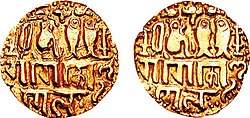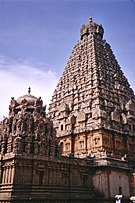
Back የቾላ ሥርወ መንግሥት Amharic चोल वंश ANP سلالة تشولا الحاكمة Arabic চোল ৰাজবংশ Assamese Dinastía Chola AST Чола (дәүләт) Bashkir Chola BBC Дзяржава Чола Byelorussian চোল সাম্রাজ্য Bengali/Bangla Txola Catalan
| Chola Dynasty | |
|---|---|
| Imperial, and Royal, dynasty | |
 Imperial coin of Emperor Rajaraja I (985–1014). Uncertain Tamilnadu mint. Legend "Chola, conqueror of the Gangas" in Tamil, seated tiger with two fish. | |
| Country | List
|
| Etymology | Chola Nadu |
| Founder | Ilamchetchenni (first documented) |
| Final ruler | Rajendra III (main branch) |
| Deposition | 1279 |
| Cadet branches | |
| Chola kings and emperors |
|---|
| Interregnum (c. 200 – c. 848 CE) |
| Related |
| Part of a series on |
| History of Tamil Nadu |
|---|
 |
The Chola dynasty[a] (Tamil: [t͡ʃoːɻɐr]) was a Tamil dynasty originating from Southern India. At its height, it ruled over the Chola Empire, an expansive maritime empire. The earliest datable references to the Chola are from inscriptions dated to the 3rd century BCE during the reign of Ashoka of the Maurya Empire. The Chola empire was at its peak and achieved imperialism under the Medieval Cholas in the mid-9th century CE. As one of the Three Crowned Kings of Tamilakam, along with the Chera and Pandya, the dynasty continued to govern over varying territories until the 13th century CE.
The heartland of the Cholas was the fertile valley of the Kaveri River. They ruled a significantly larger area at the height of their power from the latter half of the 9th century till the beginning of the 13th century. They unified peninsular India south of the Tungabhadra River and held the territory as one state for three centuries between 907 and 1215 CE.[2] Under Rajaraja I and his successors Rajendra I, Rajadhiraja I, Rajendra II, Virarajendra, and Kulothunga Chola I, the empire became a military, economic and cultural powerhouse in South Asia and Southeast Asia.[3]
- ^ The New Encyclopædia Britannica: Micropædia. Encyclopædia Britannica. 1993. p. 441. ISBN 978-0-85229-571-7.
- ^ K. A. Nilakanta Sastri, A History of South India, p 157
- ^ Keay 2011, p. 215.
Cite error: There are <ref group=lower-alpha> tags or {{efn}} templates on this page, but the references will not show without a {{reflist|group=lower-alpha}} template or {{notelist}} template (see the help page).